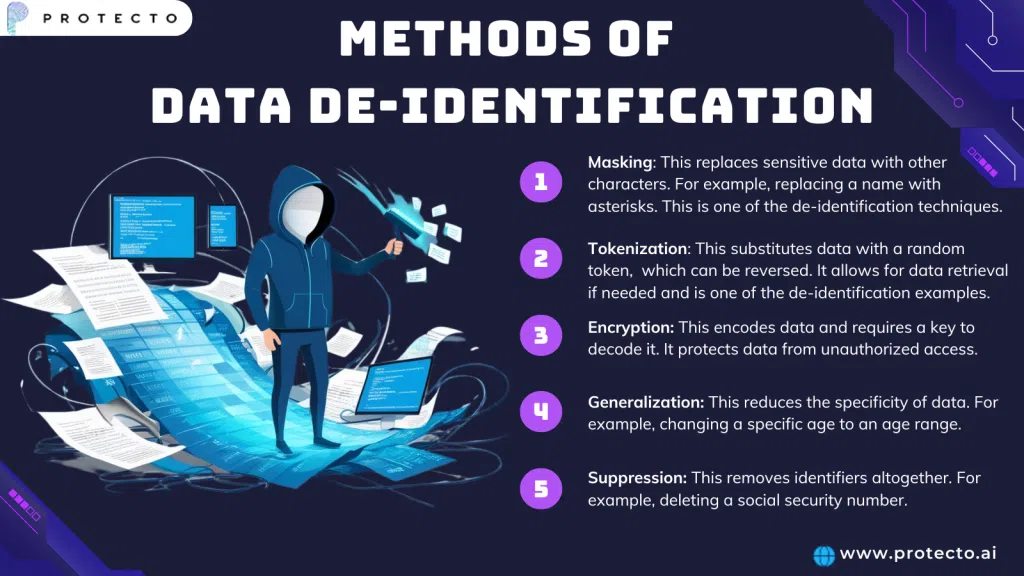What is Data De-identification?
Data is essential. Businesses, researchers, and healthcare providers rely on it. However, this data often contains sensitive personal information, creating privacy risks. Data de-identification helps mitigate these risks by removing or altering identifiers.
This makes it harder to link data back to specific individuals. This process is vital for protecting sensitive information and allowing safe data use.
Privacy is a growing concern. Regulations like HIPAA set strict rules. These rules affect sectors like healthcare and finance and impact AI development. These sectors handle large amounts of personal data and must protect this data.
The definition of de-identification is key to understanding these rules. It helps organizations comply. They can use data without compromising privacy. Understanding the de-identify data meaning is crucial. It enables responsible data handling in today’s world.
Definition of Data De-identification
De-identification refers to removing or changing personal identifiers. This process makes it challenging to connect data with a specific person, so it is essential to understand what de-identification means.
It is not the same as anonymization. Anonymization makes it impossible to re-identify individuals. De-identify data meaning focuses on reducing the risk of identification. It does not eliminate it.
De-identification plays a key role in various situations. HIPAA compliance is one. This law protects patient health information. It allows for the use of de-identified data for research and public health activities. This is done without needing individual authorization. Data sharing is another area.
De-identification enables sharing data with third parties while protecting privacy. This is useful for research collaborations and data analysis, which allows for important insights that would be difficult to obtain otherwise. De-identification allows for data use while respecting privacy, which is vital in today’s data-driven world.
Interested Read: Protecto Offers Cutting-Edge Personal Data Identification
Methods of Data De-identification
Several effective de-identification methods exist. These techniques help protect sensitive data. Each method has its own approach.
- Masking: Data Masking replaces sensitive data with other characters. For example, replacing a name with asterisks. This is one of the de-identification techniques.
- Tokenization: This substitutes data with a random token, which can be reversed. It allows for data retrieval if needed and is one of the de-identification examples.
- Encryption: This encodes data and requires a key to decode it. It protects data from unauthorized access.
- Generalization: This reduces the specificity of data. For example, changing a specific age to an age range.
- Suppression: This removes identifiers altogether. For example, deleting a social security number.
These de-identification methods offer different levels of protection. The choice of method depends on the specific use case and the data sensitivity. Combining de-identification techniques can enhance safety, ensure data privacy, and allow for useful data analysis.
Interested Read: De-identification: Understanding Protecto vs. Presidio
Importance of Data De-identification
De-identification is essential for several reasons. It addresses key concerns around data use.
Regulatory Compliance
Many regulations require data protection. HIPAA is one such regulation. It sets standards for handling de-identified health information. This allows for the use of health data. This use occurs without violating patient privacy. De-identified data HIPAA provides for research and analysis. This advances healthcare. It also protects patient rights.
Data Sharing & Analysis
De-identification enables safe data sharing, which is important in healthcare and research. De-identification of patient data allows researchers to collaborate, study diseases, and develop new treatments. De-identification of personal data in healthcare promotes innovation and improves patient care.
Mitigating Privacy Risks
De-identification of personal data reduces the risk of misuse and protects against unauthorized access. Healthcare data de-identification is important. It safeguards sensitive patient information, protecting individuals from harm and maintaining trust in healthcare systems. De-identification balances data utility with privacy protection, allowing for beneficial data use.
De-identified Data vs. Anonymized Data
De-identified vs anonymized data have key differences. De-identification reduces the risk of identifying individuals. Anonymization makes re-identification impossible. Data masking vs de-identification is a related concept. Masking is a de-identification technique. It alters data. Anonymization often involves more extensive changes. It may include data aggregation or deletion. Each approach has its own uses and challenges. Choosing the right approach depends on the specific data use case.
Interested Read: Pseudonymization vs Anonymization: Key Differences, Benefits, & Examples
Challenges and Best Practices
Challenges
Balancing data utility with privacy is a challenge. De-identification can make data less useful for some purposes, and the risk of re-identification also exists, which can have legal implications.
Best Practices
Regular audits of de-identification methods are essential, and updates should occur as needed. Combining de-identification with encryption enhances security, making it even harder to access sensitive data. These practices are critical in sectors like healthcare and finance, which handle highly sensitive information and must protect this data.
Examples of Data De-identification in Practice
De-identification has many real-world applications.
De-identification of patient data is common in healthcare. It allows hospitals to share data for research, which complies with de-identified data under HIPAA. This is a good example of healthcare data de-identification. This sharing improves patient care and advances medical knowledge.
AI and analytics also use de-identification. Companies train machine learning models. They often use large datasets, which may contain sensitive information. De-identification allows them to use this data. They can train models without exposing private details, protecting privacy while promoting innovation. This is a key use of de-identification of patient data. It allows for responsible data use.
Read Case Study: Protecting PHI in Unstructured Medical Text
Conclusion
Data de-identification is vital. It protects sensitive information and allows for valuable data use. It involves various de-identification methods. These techniques reduce the risk of identifying individuals. This is different from anonymization, which makes re-identification impossible. De-identification is important for regulatory compliance. It also enables data sharing, which promotes research and innovation.
De-identification is important in today’s data-driven world. It allows organizations to use data responsibly and protects individual privacy. Adopting strong data de-identification strategies is crucial. It allows for privacy-compliant innovation and supports safe data sharing.
Explore solutions like those offered by Protecto. These solutions can help implement effective data de-identification practices.






